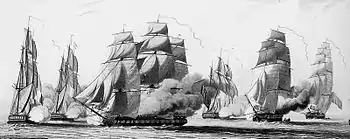HMS Madagascar (1811)
HMS Madagascar was a 38-gun Piémontaise-class frigate originally of the French Navy. Her French name had been Néréide, and she had been built to a design by François Pestel.
 Néréide at the Action of 20 May 1811 (leftmost ship) | |
| History | |
|---|---|
| Name: | Néréide |
| Namesake: | Nereid |
| Ordered: | 28 December 1805 |
| Builder: | Saint Malo |
| Laid down: | March 1806 |
| Launched: | 18 April 1809 |
| Captured: | 26 May 1811 |
| Name: | HMS Madagascar |
| Acquired: | 26 May 1811 |
| Fate: | 1819 broken up |
| General characteristics | |
| Displacement: | 1,400 tons (French) |
| Tons burthen: | 1,113 90⁄94 (bm) |
| Propulsion: | Sail |
| Complement: | 330–340 |
| Armament: |
|
| Armour: | Timber |
In 1810 as Néréide, she sailed to Guadeloupe but was repelled by the blockade off Basse-Terre, and returned to Brest after a fight with HMS Rainbow and HMS Avon.
The British captured Néréide during the action of 20 May 1811, and commissioned her into the Royal Navy as HMS Madagascar.
She took part in the Peninsular War against France, and the War of 1812 with the United States.
Madagascar, Vengeur, and Lightning were in company on 6 March 1814 at the recapture of Diamond.[Note 1] Shortly thereafter, Captain Bentinck Cavendish Doyle of Lightning transferred to take command of Madagascar.
In June 1814, Madagascar served in a flotilla under the command of Admiral Lord Cochrane, and carried General William Miller and his troops from Bordeaux to the Chesapeake Bay to reinforce General Ross in the War of 1812.1
During the Battle of North Point, a supplementary body of Royal Marines, drawn from 15 ships of the fleet, were assigned to the 2nd Battalion of Royal Marines, under the command of brevet Lieutenant Colonel James Malcolm.[2] One of the two fatalities, Thomas Daw, was from HMS Ramillies.[3][4][5]
Notes and citations
Notes
- A first-class share for Diamond was worth £59 3s 3½d; a sixth-class share was worth 10s 3¾d.[1]
Citations
- "No. 16945". The London Gazette. 12 April 1814. p. 2040.
- Crawford, p273 with reference to Rear Admiral Codrington's memo dated 11 September 1814
- "War of 1812 Casualty Database [of Crown Forces]". Retrieved 18 February 2013.
- "No. 16947". The London Gazette. 17 October 1814. p. 2075.
- "No. 16947". The London Gazette. 17 October 1814. p. 2080.
References
- Crawford, Michael J. (Ed) (2002). The Naval War of 1812: A Documentary History, Vol. 3. Washington: United States Department of Defense. ISBN 9780160512247
- Roche, Jean-Michel (2005). Dictionnaire des bâtiments de la flotte de guerre française de Colbert à nos jours 1 1671–1870. ISBN 978-2-9525917-0-6. OCLC 165892922.
- address to the Royal Artillery Historical Society 2003 Autumn Meeting by Mr Thomas Hudson, OBE, MA, 17 September 2003, at Woolwich, England.
- HMS Madagascar, Naval database
External links
 Media related to HMS Madagascar (ship, 1811) at Wikimedia Commons
Media related to HMS Madagascar (ship, 1811) at Wikimedia Commons
